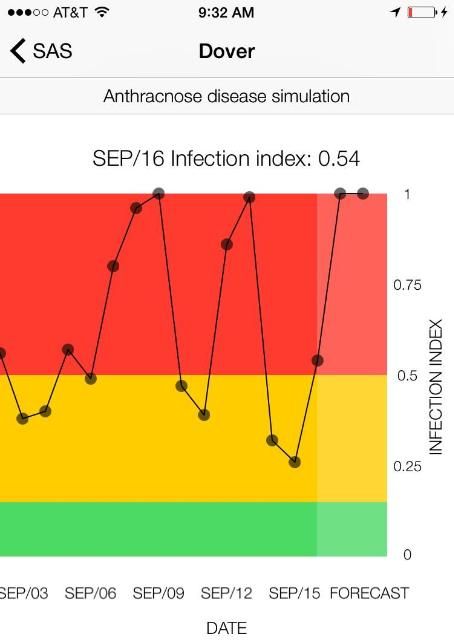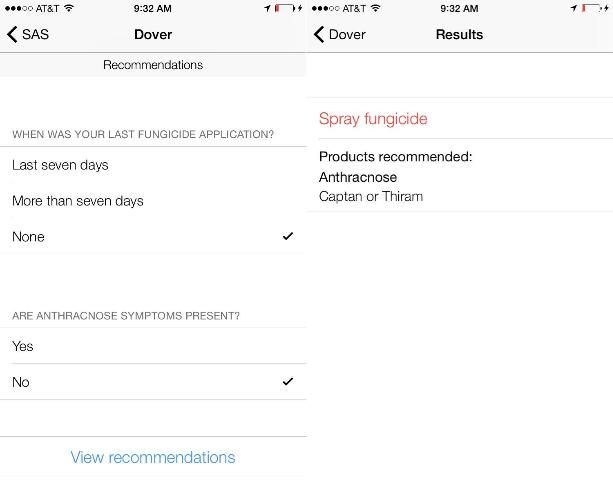Smart Strawberry Advisory System for Mobile Devices
Introduction
Mobile devices (e.g., smartphones and tablets) are revolutionizing the way information is shared around the world. Information and Communication Technologies (ICTs) have spread rapidly in recent years. Researchers and producers have shown considerable interest in the potential role of ICTs, particularly mobile phones, in marketing agricultural outputs and providing potentially yield-increasing and cost-reducing information.
Our team has developed a mobile version of the web-based Strawberry Advisory System (SAS: http://agroclimate.org/tools/strawberry/) (Pavan et al. 2011). Like the web-based SAS, the SAS—Strawberry Advisory System mobile app monitors real-time and forecast weather conditions that increase the risk for Botrytis (gray mold) and anthracnose fruit rots, providing risk level information for each disease. The app provides easy access to the information growers need to make spraying decisions in the field, saving them time, helping improve disease control, and avoiding unnecessary fungicide applications.
Overview of the SAS Mobile App
The SAS—Strawberry Advisory System app is currently available for download through the official app stores for mobile devices with iOS and Android operating systems. The app is designed to be easy to use, so it contains only the essential functionality available in the web-based SAS. For more extensive functionality, refer to the web platform and online information.
The first screen of the SAS—Strawberry Advisory System app shows a map of the strawberry producing regions in Florida and the current disease risk level for all weather stations included in the system. The diseases' risk levels are represented by colors and letters: green means "Low Risk," orange means "Moderate Risk," and red means "High Risk" for either anthracnose (represented by the letter "A") or Botrytis (represented by the letter "B"). Users can select a weather station to display a panel at the bottom of the screen showing the risk levels for that location and the time at which the information was last updated (Figure 1).

Credit: Clyde Fraisse, UF/IFAS Extension
Users also have the option to select one of the diseases in order to review the risk level over the last 30 days and the forecast for the next two days, or to ask for a specific fungicide recommendation. When a disease is selected, a graph displaying infection risk levels is loaded, showing the variability of the infection index during the last two weeks. The forecast for the next two days appears on the right side of the screen. Users can roll the graph horizontally to display risk levels up to 30 days before the current date (Figure 2).

Infection risk levels are simulated in the system based on disease models developed and evaluated in previous studies (MacKenzie and Peres 2012a, b). These models require leaf wetness duration and temperature data from weather stations operated by the Florida Automated Weather Network (FAWN) to predict when conditions are favorable for disease development.
If the user chooses to view a specific recommendation, a screen with a short questionnaire requesting additional information is presented. The goal here is to learn which fungicide product was last used, the application date, and the phenological stage of the crop. Based on the user's answers, a recommendation is generated. SAS recommendations also help reduce the threat of widespread resistance within pathogen populations due to intensive chemical use.

The SAS—Strawberry Advisory System mobile app can provide alerts for user-selected stations via push notifications, alerting when the system detects moderate or high infection risk levels according to weather conditions.
Summary
The SAS—Strawberry Advisory System mobile app provides an easy way for strawberry growers in Florida to track and forecast risk levels for Botrytis and anthracnose fruit rot diseases. It also provides fungicide application recommendations and allows growers to receive alerts for selected weather stations via push notifications. The Strawberry Advisory System mobile app is available at no cost for iOS (iPhone, iPad, and iPod Touch) and Android operating systems at the App and Google Play stores.
Acknowledgements
The SAS—Strawberry Advisory System mobile app was developed under the "Smart Strawberry Advisory System for Mobile Devices" project (UF award 00094591), funded by the Florida Strawberry Research and Education Foundation.
References
MacKenzie, S. J., and N. A. Peres. 2012a. "Use of leaf wetness and temperature to time fungicide applications to control anthracnose fruit rot of strawberry in Florida." Plant Disease 96: 522–28.
MacKenzie, S. J., and N. A. Peres. 2012b. "Use of leaf wetness and temperature to time fungicide applications to control Botrytis fruit rot of strawberry in Florida." Plant Dis. 96: 529–36.
Pavan, W., C. W. Fraisse, and N. A. Peres. 2011. "Development of a web-based disease forecasting system for strawberries." Computers and Electronics in Agriculture 75: 169–75.


